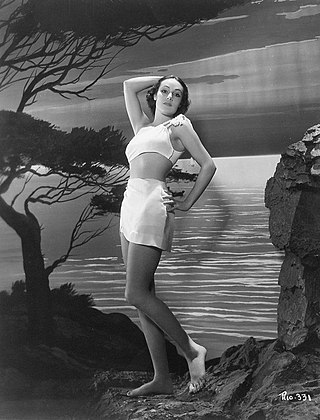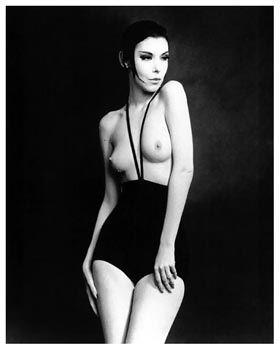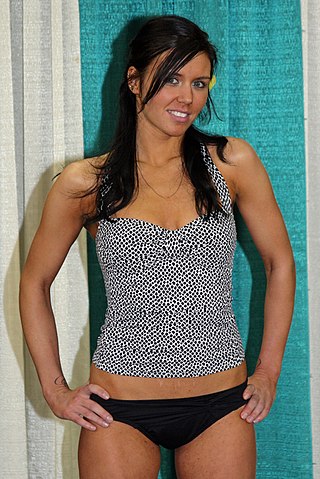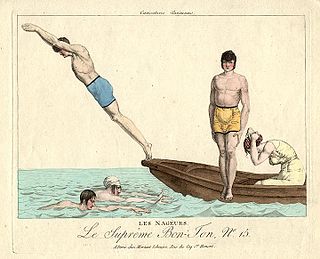
A bikini is a two-piece swimsuit primarily worn by girls and women that features one piece on top that covers the breasts, and a second piece on the bottom: the front covering the pelvis but usually exposing the navel, and the back generally covering the intergluteal cleft and some or all of the buttocks. The size of the top and bottom can vary, from bikinis that offer full coverage of the breasts, pelvis, and buttocks, to more revealing designs with a thong or G-string bottom that covers only the mons pubis, but exposes the buttocks, and a top that covers only the areolae. Bikini bottoms covering about half the buttocks may be described as "Brazilian-cut".

A swimsuit is an item of clothing designed to be worn by people engaging in a water-based activity or water sports, such as swimming, diving and surfing, or sun-orientated activities, such as sun bathing. Different types may be worn by men, women, and children. A swimsuit can be described by various names, some of which are used only in particular locations or for particular types of suit, including swimwear, bathing suit, bathing attire, swimming costume, bathing costume, swimming suit, swimmers, swimming togs, bathers, cossie, or swimming trunks, besides others.

The monokini was designed by Rudi Gernreich in 1964, consisting of only a brief, close-fitting bottom and two thin straps; it was the first women's topless swimsuit. His revolutionary and controversial design included a bottom that "extended from the midriff to the upper thigh" and was "held up by shoestring laces that make a halter around the neck." Some credit Gernreich's design with initiating, or describe it as a symbol of, the sexual revolution.

Dolce & Gabbana, also known by initials D&G, is an Italian luxury fashion house founded in 1985 in Legnano by Italian designers Domenico Dolce and Stefano Gabbana. The house specializes in ready-to-wear, handbags, accessories, cosmetics, and fragrances and licenses its name and branding to Luxottica for eyewear.

The tankini is a bathing suit combining a tank top, mostly made of spandex-and-cotton or Lycra-and-nylon, and a bikini bottom introduced in the late 1990s. This type of swimwear is considered by some to provide the coverage of a one-piece suit with the convenience of a two-piece suit, as the entire suit need not be removed in order to use a toilet. Tankinis come in a variety of styles, colors, and shapes, and some include features such as integrated push-up bras. It is particularly popular as children's beachwear, and is considered an athletic outfit fit for a triathlon. According to Katherine Betts, Vogue's fashion-news director, this amphibious sportswear for sand or sea lets users go rafting, play volleyball, and swim without worrying about losing their tops.

Fernanda Tavares is a Brazilian model.

The most characteristic North American fashion trend from the 1930s to 1945 was attention at the shoulder, with butterfly sleeves and banjo sleeves, and exaggerated shoulder pads for both men and women by the 1940s. The period also saw the first widespread use of man-made fibers, especially rayon for dresses and viscose for linings and lingerie, and synthetic nylon stockings. The zipper became widely used. These essentially U.S. developments were echoed, in varying degrees, in Britain and Europe. Suntans became fashionable in the early 1930s, along with travel to the resorts along the Mediterranean, in the Bahamas, and on the east coast of Florida where one can acquire a tan, leading to new categories of clothes: white dinner jackets for men and beach pajamas, halter tops, and bare midriffs for women.
Jantzen is a brand of swimwear that was established in 1916 and first appeared in the city of Portland, Oregon, United States. The brand name later replaced the name of the parent company that manufactured the branded products. The brand featured a logo image of a young woman, dressed in a red one-piece swimsuit and bathing hat, assuming a diving posture with outstretched arms and an arched back. Known as the Jantzen "Diving Girl", the image in various forms became famous throughout the world during the early twentieth century.

Louis Réard was a French automobile engineer and clothing designer who introduced the modern two-piece bikini in July 1946. He opened a bikini shop and ran it for the next 40 years.

Jacques Heim was a French fashion designer and costume designer for theater and film, and was a manufacturer of women's furs. From 1930 to his death in 1967, he ran the fashion house Jacques Heim, which closed in 1969. He was president of the Paris Chambre Syndicale de la haute couture from 1958 to 1962, a period of transition from haute couture to ready-to-wear clothing.

Many stylistic variations of the bikini have been created. A regular bikini is a two-piece swimsuit that together covers the wearer's crotch, buttocks, and breasts. Some bikini designs cover larger portions of the wearer's body while other designs provide minimal coverage. Topless variants are still sometimes considered bikinis, although they are technically not a two-piece swimsuit.

Evidence of bikini-style women's clothing has been found as early as 5600 BC, and the history of the bikini can be traced back to that era. Illustrations of women wearing bikini-like garments during competitive athletic events in the Roman era have been found in several locations, the most famous of which is at Villa Romana del Casale.

The thong is a garment generally used as either underwear or in some countries, as a swimsuit. It may also be worn for traditional ceremonies or competitions.
Italy is one of the leading countries in fashion design, alongside France and the United Kingdom. Fashion has always been an important part of the country's cultural life and society, and Italians are well known for their attention to dress; la bella figura, or good appearance, retains its traditional importance.

Stefano Gabbana is an Italian fashion designer and, along with Domenico Dolce, the co-founder of the Dolce & Gabbana luxury fashion house.

Domenico Mario Assunto Dolce is an Italian fashion designer and entrepreneur. Along with Stefano Gabbana, he is one half of the luxury fashion house Dolce & Gabbana (D&G). Since founding D&G in 1985, Dolce has become one of the world's most influential fashion designers and an industry icon.

Hannah Emily Rose Ferguson is an American model.

The history of swimwear traces the changes in the styles of men's and women's swimwear over time and between cultures, and touches on the social, religious and legal attitudes to swimming and swimwear.

The COVID-19 pandemic affects the global fashion industry as governments close down manufacturing plants, and through store closures, and event cancellations to attempt to slow the spread of the virus. The COVID-19 pandemic has had a major impact on fashion brands worldwide. At the same time, the fashion industry faces challenges in consumer demand. New opportunities are also presenting themselves as fashion brands shift to making fashionable COVID-19 face masks. Domenico de Sole, chairman of Tom Ford International, remarked that "I have seen a lot of difficult situations in my long career and this has been the most devastating event, not just for fashion and luxury, but all industries."
Sohee Park is a South Korean womenswear designer based in London, United Kingdom. She is known for her clothing label Miss Sohee, which specializes in couture.

















